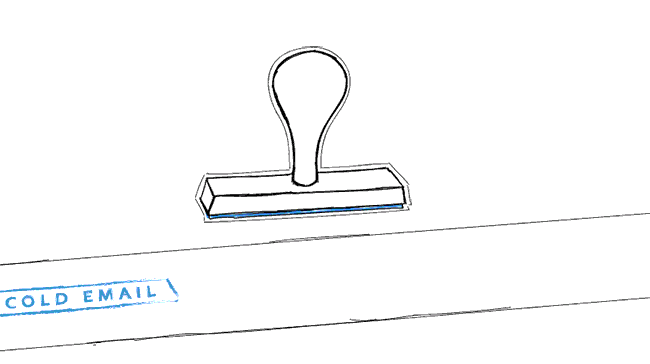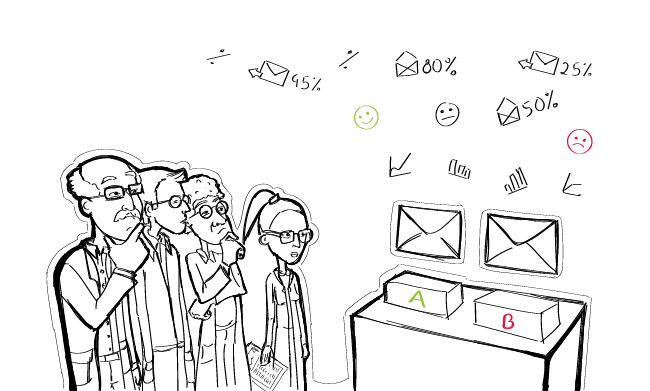If you’re sending cold emails, you know that sometimes your messages work amazingly well, sometimes they work OK, and sometimes they don’t work at all. And whether your outreach works great, or it hardly works at all, there’s always a reason for that. Actually, in most cases, there’s a whole collection of reasons for that. Here’s a list of 10 factors that you may want to check to discover the cause of your campaign’s success or failure, and to improve the effectiveness of your emails in general.
I’ve divided the 10 factors into three categories: Copy, Settings, and a special factor that is a category for itself.
Copy
That is the content of your messages. What do you actually write to your prospects? What language do you use to communicate with them? If your outreach doesn’t work the way you want it to, check the copy of your messages first.
1. From line
That’s what your prospect sees right next to the subject of your message. That’s the label you put on yourself for the first impression. That’s who you are to them even before they open your message. That’s what may decide whether they are going to open your message or not. How you should present yourself in the from line depends very much on your group of prospects, and the aim of your message. More about it in one of my previous posts:
What Should Be the ‘’From” Line of My Cold Email? >>
2. Subject
The subject line affects the open rate of your email. If you make it sound too salesy, probably fewer prospects will open your email. If you make it shocking, but irrelevant to the body of your email, probably your open rates will be high, but your positive response rate will be utterly disappointing.
But if you make it personalized, relevant to the addressee, and intriguing, it will be the first step to starting a new B2B relation. There’s a whole post on subject lines right here:
What Subject Line Will Make My Addressees Open My Cold Email? >>
3. Intro (personalization)
That is how we start our email. If we focus on ourselves from the very beginning, the addressee may lose interest very fast. And the role of the introductory section is to drag them into the message – make them interested, make them want to read further. The key is to understand that people don’t like to read about perfect strangers, which is who we are to them, but they like to read about themselves instead.
Personalization is the magic word when it comes to cold emails in general, but it plays a special role in cold email intro. If you’d like to learn more about effective cold email introductions and the ways to make them more personalized, you may want to check the two links below:
Cold Email Intro, or How Should I Start My Message? >>
How to Make My Cold Emails Personal? Vol.2: Copy >>
4. Value proposition
That’s where you tell your prospects what they can gain if they decide to respond to your email. That’s where you tell them about your offer, but ideally without focusing on yourself and without a longish list of your product’s features. In other words, that’s where you have to tell them about your solution while still talking about their problems. A difficult part of a cold email to write well. Check out what I’ve learned about that here:
Value Proposition – How to Tell My Addressee What I Want >>
Features vs. Benefits – How to Present Your Product in a Cold Email? >>
5. CTA
The CTA (call to action) should end every cold email. Check if you have it, what it looks like, and what it really tells your addressee to do. The more specific you are in the CTA as to the next step you expect from them, the easier it will be for them to reply. To see what I mean in detail and on examples, follow the link below:
Perfect CTA, or How to End Up My Cold Email? >>
6. Signature
Yes, that is a tremendously important part of your cold email and despite that everyone knows it, 90% of cold emails I get DOES NOT include a proper signature. If I can’t check the sender’s full name, their company website, and location, how can I trust them? Check if your signature actually plays the important role it should play in your email:
A Little Big Thing – What Do I Put in My Email Signature? >>
That’s pretty much it when it comes to copy. Now, there are also your campaign settings that decide whether your prospects get your emails at the right time, how many follow-ups they get, and where they get all these from.
Settings
7. Sender’s email address
Seems obvious, but it isn’t so in every case. The email address, as well as the From line, decides if the sender seems trustworthy or not. Say you get a nicely-crafted email from an email address like [email protected]. Would you think it’s been sent to you by a real trustworthy person who actually cares about you and your business?
Maybe it has, but the problem is: we start wondering. At the moment we check their email addresses, we have some doubts. And the prospect should not wonder if they can trust us or not. They should have no doubts that the person on the other side of the screen can be trusted and that she really cares about them. That’s why the email address we send our campaign from is an important factor that affects the effectiveness of our outreach.
8. Timing of the opening email and follow-ups
Delivery time affects the engagement of our prospects, just as it affects the engagement of newsletter subscribers (that’s actually one of few points cold emails and newsletters have in common). The perfect timing for sending cold emails to your group of prospects is a variable you need to discover for yourself. Stats published by others may help, but they won’t necessarily be a perfect fit for you. More about it here:
What We’ve Figured Out about Optimal Time for Cold Email Delivery: Vol. 1 Stats >>
9. Number of follow-ups
Follow-ups help boost response rates. But how many follow-ups should we send, and how often should we send them for an optimal response? For a short analysis of possible approaches, check out the post linked below:
Follow-up Emails: How Many & How Often? >>
And last but not least…
The special ingredient that involves lots of research long before we even start sending anything. The factor we cannot directly control, but we can only make assumptions on and verify those assumptions by testing.
10. Well-researched and properly targetted group of prospects
I put it at the end of my list, but in fact, it’s the most crucial factor. A well-researched base of carefully selected addressees is something we cannot omit if we want to make our cold emails work – that is if we want the emails to bring us positive replies that start valuable relations. Why?
Well, even if we crafted perfect personalized messages, we followed all the rules, we included all the necessary elements, and took care of the most important settings, we may not succeed at first.
And that’s perfectly normal. Successful cold email outreach is built on the way of persistent testing and continuous research. We need to find our own way of talking to our prospects, and the way can be verified only by experience.
Finally, and most importantly, we need to learn what the real needs and fears of our prospects are, so we could refer to them in our messages. If the solution we present in our cold email is an answer to their actual problem, they will be eager to talk to us and learn more. And that’s our goal.
If you’re still looking for a way to research your prospect group before you reach out to them, check out some of the ideas that usually help me in the process:
How to Make My Cold Emails Personal? Vol.1: Research >>
Anything I missed?
If you feel like I didn’t mention a factor that appeared to be crucial for your cold email outreach, please share your experience in the comments. I’ll be more than happy to learn something new and discover a fresh perspective.
READ ALSO

Cold Email Clichés, or What Your Prospects Have Seen Too Many Times to Care
If you've been into cold emails for some time, or if you get hundreds of cold emails into your inbox, you are probably able to quote some cliché phrases and structures showing up over and over again for years. I described just a few of them below. Check if you know them. Check if you use them. Check how to replace them, which may probably boost your reply rates.

What Mail Merge Custom Fields Can I Use for Clever Outreach?
What are mail merge custom fields, dynamic fields, or snippets? However you call them, these are just the pieces of information about each of your prospects that can be merged into your email templates to make your messages catch people's attention. Oh, and one more thing - successful cold email outreach can't be done without them. In this post, I'm sharing some ideas for custom fields, other than the traditional first name and company name. Learn where to find them and how to add them to your prospect base for more effective personalization at scale.

My Open, Reply or Interest Cold Email Metrics are Low, What Can I A/B Test?
Cold outreach needs a lot of experimentation before you get it right. You can tinker with cold email copy, subject line, CTA, and other elements to optimize your cold email. However, how do you know what to focus on?
